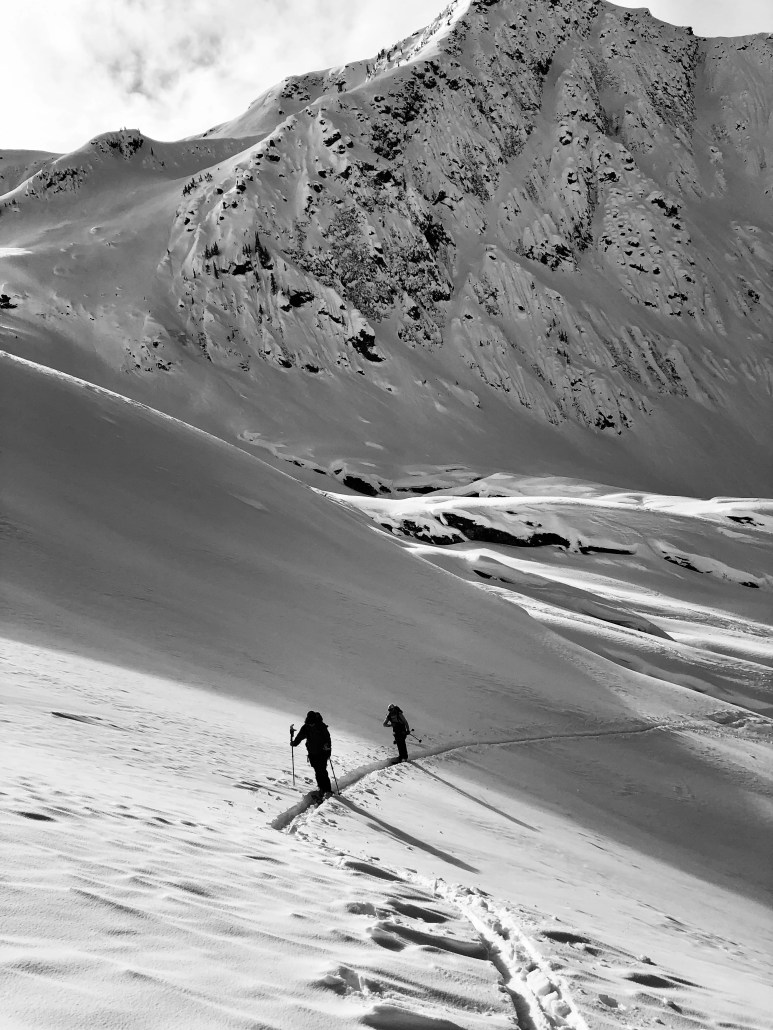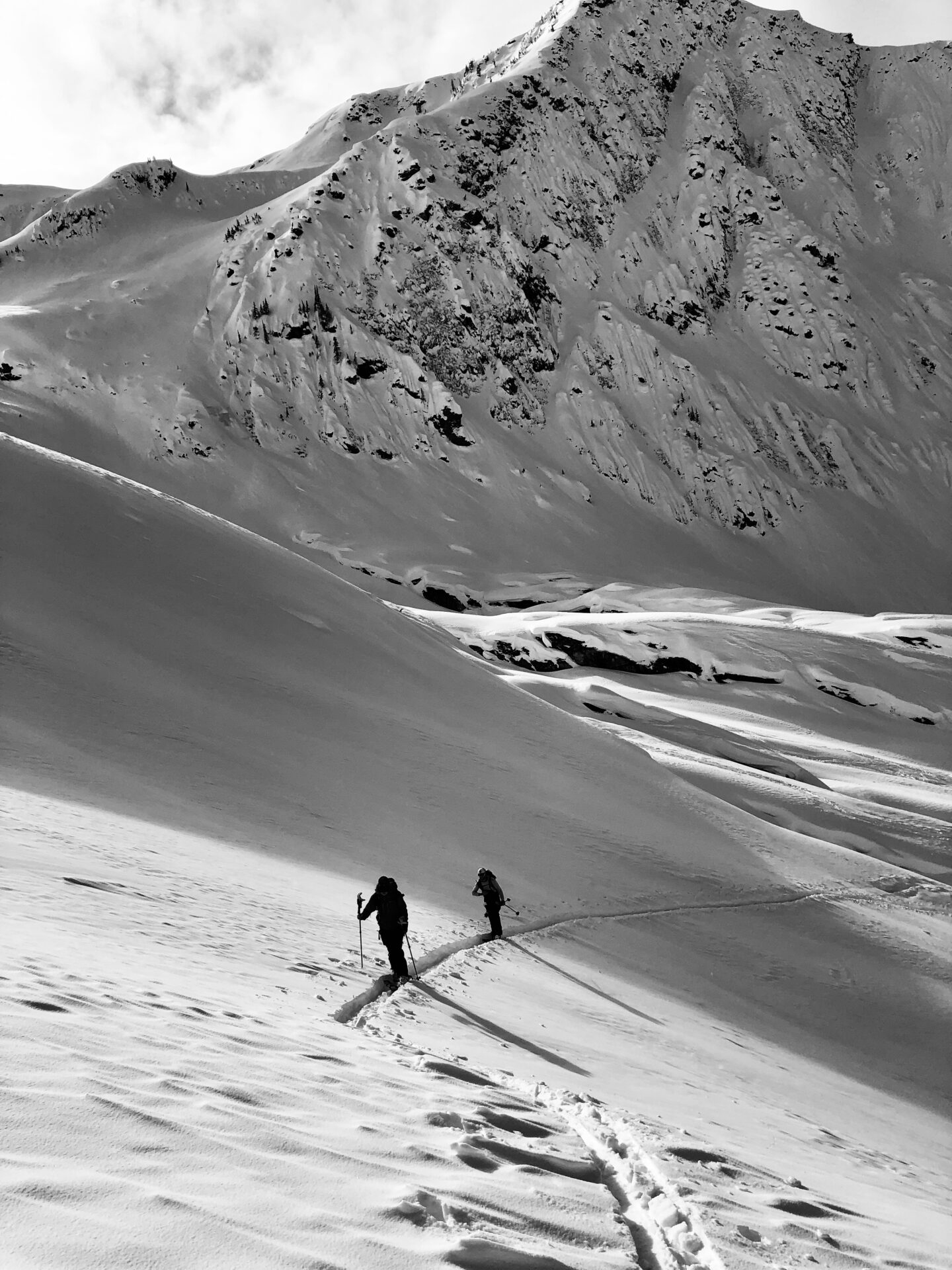Rogers Pass Backcountry Conditions Report March 5, 2023
Rogers Pass Backcountry Conditions Report March 5, 2023
Current Snowpack Synopsis
Pow, the story continues! Since January 30th, Ullr has delivered 204mm of snow water equivalent to the snowpack. Mt Fidelity’s weather station at 1905m is now reading 276cm for a height of snow. According to the Mt Fidelity weather station, 65cm of storm snow has fallen, with 59cm of settlement in the height of snow.
What’s that mean? The upper and mid pack are continuing to settle and bond and are slowly bridging and squashing the November facets at the bottom of the snowpack.
65cm of low density recent storm snow has fallen in since Feb 26, which was accompanied by moderate to strong S-SW flow (Gusting to extreme on Thursday.). The clearing trend that has ushered in continued cold temperatures has been driven by light to moderate winds out of the North. This recent storm snow overlies colder and lower density storm snow from last week and wide spread wind effect (sastrugi in some parts of the alpine) that reached into exposed areas below tree line. On steep solar aspects, a new melt freeze crust exists in sheltered areas below 2300m. In sheltered areas (BTL-ALP), 2mm surface hoar needles were observed.
The mid-pack is gaining strength and rounding with the continued precipitation we’ve had recently.
However the November facets are still prominent at the base of the snowpack. The facets are showing signs of rounding, but there is still a considerable step in resistance between them and the overlying snow. The November facets are more pronounced in shallow rocky areas.
What’s been riding well
Over the past week there has been exceptional storm riding paired with cold smoke powder in the alpine. Deep trail breaking continues to be a recent theme.
With the arrival of clear skies, sheltered alpine features and sheltered areas at tree line and below have been the place to be. In exposed areas, storm slabs exist in immediate lee features. Cracking and storm slabs reactive to skier traffic have been observed in the alpine and in exposed tree line features.
The recent melt freeze crust on steep solar aspects is thin, but it does affect riding quality; look to ride on the shady sides of trees when travelling in BTL solar areas.
Recent Avalanche Activity
This has been a significant storm cycle and has produced natural avalanches to size 3.5 near Rogers Pass and explosive results to size 4. During Thursday’s wind event, there were numerous natural slab avalanches. Frequent Flier hit the Connaught Creek up track during this event. The November facets continue to produce avalanches and are reactive to large loads and skier traffic in the Columbia Mountains, see the Bruins Ridge Mountain Conditions Report
Minimize your exposure to cornices, they are big and have faceted roots. Natural cornice failures have been observed in Rogers Pass and surrounding areas.
Recent moderate to strong south and southwest winds created storm slabs in immediate lee features and contributed to a natural avalanche cycle on Thursday night and into Friday. Winds have subsequently switched to a northerly flow, so heads up for an atypical loading pattern.
On Monday February 27th, there was a skier accidental size 2.5 on Bruins Ridge. The 12th skier who crossed the slope that links the ridge into 8812 Bowl triggered the avalanche and fortunately was able to self arrest when the slab fractured at his feet. This feature has avalanched twice before this season and this avalanche failed just above the ground on facets. The crown was roughly 100m wide and ranged from 45cm to 1.3m. The avalanche ran approximately 800m into the flats of 8812 Bowl. 
Natural cornice failures have been observed recently too. The cold temps have continued to facet out the roots of cornices. The new snow coupled with the wind will have surely built fresh new additions to the cornices that will be fragile. Be vigilant and minimize your exposure to them

Incoming weather and avalanche forecast
A mix of sun and flurries. While cold arctic air pushes in from the north, a low to the southwest continues to push moisture into the region. Ridgetop winds will be in the light to moderate range from the north trending to the southwest later in the week. Later in the week, a low pressure system coming from the southwest will make its way towards the Columbia Mountains, bringing more snow!
Avalanche Canada Mountain Weather Forecast
Avalanche Canada Public Avalanche Forecast
Snowpack Concerns
Cornices: Minimize your exposure to cornices, they are big and have faceted roots. Cornices have grown significantly in recent weeks and there have been numerous natural cornice failures that have resulted in avalanches up to size 3 in, or around Rogers Pass. Give them respect and a wide birth when you are travelling under them. Be cautious of solar input.
Storm slabs: Recent moderate to strong winds have caused storm slabs in exposed areas in alpine, tree line and below tree line features. There has been a natural cycle to size 3.5 over the week and these storm slabs will be reactive to rider traffic in the next few days. Watch out for reverse loading with the current northerly flow.
Dry Loose: Watch out for sluffing in terrain over 35 degrees. Sluffs have been running fast and far over the weekend.
Deep Persistent Slabs: The November facets are still very much a concern across the backcountry ski / snowboard industry in the Columbia Mountains. This past week exhibited continued natural avalanche activity failing on the November facets. They will need a bit of time to adjust to the new load that has been applied to them.
Be aware of overhead hazard.
The November facets are more pronounced in shallow, rocky features. Professionals are still maintaining a conservative mindset with this low probability/ high consequence avalanche problem.
Access Concerns
Disclaimer
Backcountry skiing and splitboarding are inherently dangerous activities. Decisions made about terrain in which you may choose to travel should be based on real time data you’ve collected firsthand, not on this report. Conditions in the mountains change rapidly, please be aware that things will probably have changed since this report was written.






